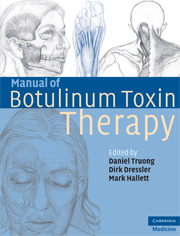Book contents
- Frontmatter
- Contents
- List of contributors
- Foreword – Alan B. Scott
- Preface
- 1 The pretherapeutic history of botulinum toxin
- 2 Botulinum toxin: history of clinical development
- 3 Pharmacology of botulinum toxin drugs
- 4 Immunological properties of botulinum toxins
- 5 Treatment of cervical dystonia
- 6 Treatment of hemifacial spasm
- 7 Treatment of blepharospasm
- 8 Treatment of oromandibular dystonia
- 9 Treatment of focal hand dystonia
- 10 Botulinum toxin applications in ophthalmology
- 11 Botulinum toxin therapy of laryngeal muscle hyperactivity syndromes
- 12 The use of botulinum toxin in otorhinolaryngology
- 13 Spasticity
- 14 The use of botulinum toxin in spastic infantile cerebral palsy
- 15 Hyperhidrosis
- 16 Cosmetic uses of botulinum toxins
- 17 Botulinum toxin in the gastrointestinal tract
- 18 Botulinum toxin in urological disorders
- 19 Use of botulinum toxin in musculoskeletal pain and arthritis
- 20 The use of botulinum toxin in the management of headache disorders
- 21 Treatment of plantar fasciitis with botulinum toxin
- 22 Treatment of stiff-person syndrome with botulinum toxin
- 23 Botulinum toxin in tic disorders and essential hand and head tremor
- 24 Developing the next generation of botulinum toxin drugs
- Index
- References
3 - Pharmacology of botulinum toxin drugs
Published online by Cambridge University Press: 28 July 2009
- Frontmatter
- Contents
- List of contributors
- Foreword – Alan B. Scott
- Preface
- 1 The pretherapeutic history of botulinum toxin
- 2 Botulinum toxin: history of clinical development
- 3 Pharmacology of botulinum toxin drugs
- 4 Immunological properties of botulinum toxins
- 5 Treatment of cervical dystonia
- 6 Treatment of hemifacial spasm
- 7 Treatment of blepharospasm
- 8 Treatment of oromandibular dystonia
- 9 Treatment of focal hand dystonia
- 10 Botulinum toxin applications in ophthalmology
- 11 Botulinum toxin therapy of laryngeal muscle hyperactivity syndromes
- 12 The use of botulinum toxin in otorhinolaryngology
- 13 Spasticity
- 14 The use of botulinum toxin in spastic infantile cerebral palsy
- 15 Hyperhidrosis
- 16 Cosmetic uses of botulinum toxins
- 17 Botulinum toxin in the gastrointestinal tract
- 18 Botulinum toxin in urological disorders
- 19 Use of botulinum toxin in musculoskeletal pain and arthritis
- 20 The use of botulinum toxin in the management of headache disorders
- 21 Treatment of plantar fasciitis with botulinum toxin
- 22 Treatment of stiff-person syndrome with botulinum toxin
- 23 Botulinum toxin in tic disorders and essential hand and head tremor
- 24 Developing the next generation of botulinum toxin drugs
- Index
- References
Summary
Introduction
Botulinum toxin (BT) drugs consist of a complex mixture of substances. All of those components can differ between BT drugs. Therapeutically the most important difference refers to the botulinum neurotoxin (BNT) serotype used. So far, only types A and B are commercially available, whereas types C and F have been tried in humans on an experimental basis only. Types A and B have a substantially different affinity to the motor and to the autonomic nervous system (Dressler & Benecke, 2003). Other ingredients can also vary. The pH 5.4 buffer system of NeuroBloc®/Myobloc® increases the injection site pain as compared to all other BT drugs using pH 7.4 buffer systems. Hengli® is the only BT drug applying gelatine stabilization, which may cause allergic reactions. Other differences in protein content may affect tissue perfusion and antigenicity. Clearly, the commercially available BT drugs are not identical. Some of their differences matter therapeutically, others, however, seem not to matter. Contrary to a commercially biased belief BT drugs can be compared and should be compared. “Uniqueness” does not exist amongst BT drugs, whereas differentiation does.
Structure
As shown in Figure 3.1, BT drugs consist of the BT component and excipients. Excipients include lactose, sucrose, and serum albumin for stabilization purposes and buffer systems for pH calibration. The BT component is formed by BNT and by non-toxic proteins also known as complexing proteins.
- Type
- Chapter
- Information
- Manual of Botulinum Toxin Therapy , pp. 13 - 22Publisher: Cambridge University PressPrint publication year: 2009
References
- 5
- Cited by

